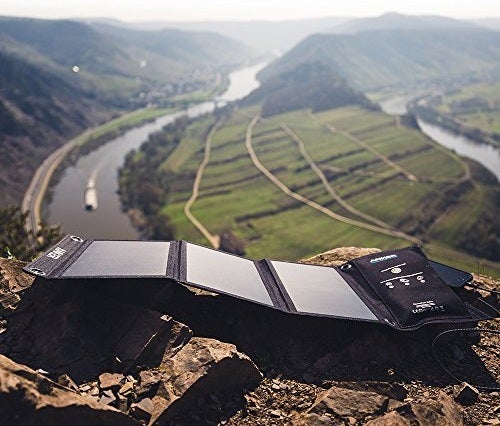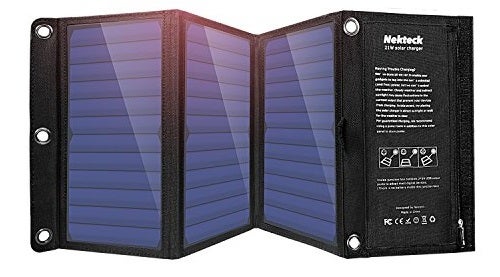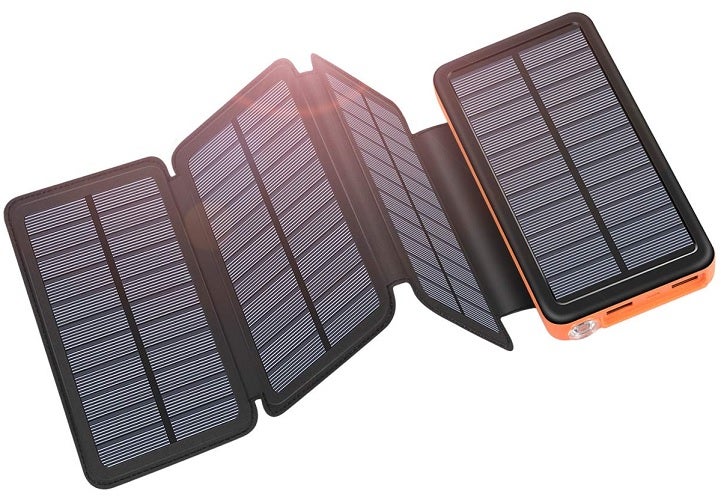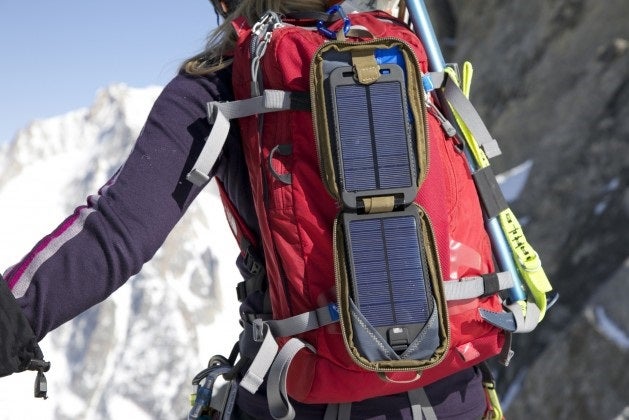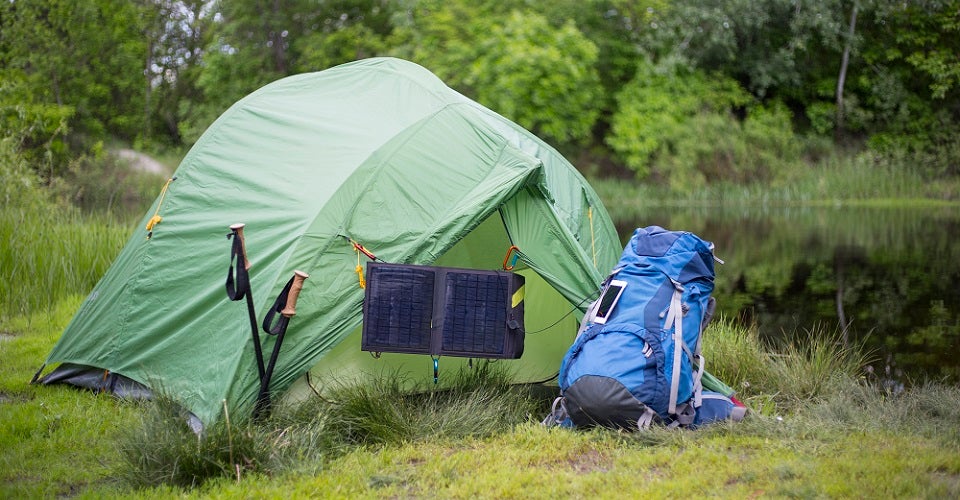
Our Editors independently research, test, and rate what we feel are the best products. We use affiliate links and may receive a small commission on purchases.
Whether you are out hiking or just around town, if you are away from a charging source a portable solar charger will be invaluable.
The best solar charger will recharge all of your battery-powered electronic equipment, such as a GPS, smartphone, camera or flashlight.
Harnessing the power of the sun presents itself as the natural solution, at least in areas where you can rely on a couple of hours of sunshine per day.
Best Solar Chargers
For more of my hiking recommendations, have a look through these popular Outside Pursuits guide links: Hiking Backpacks, Solar Backpacks, Hiking Shoes.
Quick Answer: The 7 Best Rated Solar Chargers For 2021
- Anker 21W Dual USB Solar Charger
- Goal Zero Guide 10 Solar Recharging Kit
- Nekteck 20W Solar Charger with 2-Port USB Charger
- ADDTOP Portable Solar Power Bank Kit
- Powertraveller Extreme Portable Outdoor Solar Charger
- ECEEN 10W Folding Solar Panel
- GoerTek Solar Charger & Power Bank
Our guide and comparison table of the top rated solar chargers will help you choose the right charger for you to stay powered up even in the middle of nowhere.
Solar Charger Reviews
#1 Anker 21W Dual USB Portable Solar Charger
- Power output: DC 5V / 3A
- Two high amperage USB ports
- Weighs 14.7 ounces
- Only 1.1 inches thick
- Folded dimensions: 11.1 x 6.3 x 1.1 inches
The Anker PowerPort is our top pick for the best solar charger since it offers an amazing combination of price, portability, and charging speed.
Its performance leaves most of the comparable competition behind and it delivers where it counts: reliable power output.
The Anker PowerPort delivers 21 Watts, however under real-world conditions, your average will vary depending on the sunlight. It can reliably provide a full charge for a tablet or up to two smartphones.
There is a small pouch for stowing your iPhone or Android phone while charging, but it won’t hold a tablet or many additional cables. When opened, it measures 26.4 x 11.1 x 0.2 inches, and there are stainless steel eye holes to easily attach it to almost anything.
The PowerPort is incredibly durable, thanks to its industrial-strength PET plastic faced solar panels, which are sewn into a high-wear polyester canvas.
Anker uses a fast charging technology called PowerIQ. The solar panel adjusts the amperage automatically to match your device, allowing the fastest charge possible under safe conditions.
It also goes back to the fastest speed after any interruption, such as brief shade. The PowerPort delivers up to 2.4A per port or up to 3A overall in direct sunlight with unmatched efficiency. With its small size and light weight, the Anker 21W is the best solar charger for backpacking.
The device includes a 3 foot Micro USB cable and an 18-month warranty. If you’re convinced by the Anker PowerPort 21W but is overkill for your needs, you’ll be happy with the Anker PowerPort 15W.
#2 Goal Zero Guide 10 Plus Solar Recharging Kit
- Two high speed USB ports, 4.8A for fast charges
- 2300mAh Power Bank
- Total weight of 1.56 pounds
- Built-in Micro USB tip for tangle-free charging and certified cables
- Unfolded size: 9 x 1.5 x 17 inches
This Solar Charging Kit by Goal Zero consists of two products, the Venture battery pack and the Nomad 7 solar panel. The kit is ideal for charging an iPhone, cameras, tablets while harnessing solar power in rough conditions.
The battery pack has a capacity of 2300mAh, while the solar output of the panel is 7W. With a weather rating of IPX6, the kit is able to withstand heavy rain, making it our most durable, rugged and weatherproof solar charger.
The Goal Zero Guide 10 Plus Recharging Kit is waterproof while in use without the need for rubber plugs. You can charge one tablet or two to three phones at a time.
A zippered pocket on the back holds three connectors: a USB port with 1A maximum, an 8mm plug for charging 12V devices, and a proprietary plug for chaining up several Nomad 7 panels.
The Nomad 7 comes with little magnets to hold the panels closed and two small carabiners for mounting.
The battery pack has charging LEDs which can double as a flashlight, a rubberized exterior for grip even when wet, and a Smart Charge mode which delivers the fastest and safest charge possible for each device.
When charging stationary, the most effective way is to connect the battery to the solar panel and your devices to the battery, thus charging everything at once, although at a slower rate.
On the go, simply charge the battery and use it to power up your device afterwards.
The Goal Zero Guide 10 Plus Solar Recharging Kit is for you if you want the best portable solar charger with the versatility of an included battery and need something rugged and durable because you expect rough and wet conditions.
#3 Nekteck 20W Solar Charger with 2-Port USB Charger
- 3 highly efficient Monocrystalline panels
- 5V output over 2 USB ports
- 3A current output over both ports or up to 2A over one
- Folded dimensions of 6.3 x 11.1 x 1.06 inches
- Opened up, the charger covers an area of 26.3 x 11.1 inches
The Nekteck Solar Charger is nearly as efficient as our top pick, the Anker PowerPort, while its price tag makes it a budget option.
This charger does not include a battery, so its lightweight at just 18 ounces and very portable. It consists of three fold-out solar panels with a combined output of 21W.
The highly efficient panels can reach a power conversion rate of up to 21% to 24%, allowing you to charge two devices at once over the dual USB ports.
The panels are fitted neatly into a rugged, durable canvas to withstand outdoor use, and the panels won’t mind exposure to damp conditions such as morning dew or light rainfall.
Five steel eye holes in the canvas allow you to attach the panels to nearly anything. While the case has a small pouch for a device or cables, carabiner are not included, however.
Nekteck uses their own fast charging technology called SmartIC, which is a microchip that detect the devices plugged into the USB ports for full charging speed under safe conditions.
Each panel outputs approximately 800 to 1,000mA in strong sunlight for a total maximum of 3A. In real-world conditions, you can expect a maximum of 10,000mAh during one day, which is sufficient to charge a small battery pack.
The Nekteck Solar Charger is great for charging devices or a battery pack while camping or on the go in the great outdoors, and it comes with a 30 inch Micro USB cable and a 18-month warranty.
With its light weight and ruggedness its the best solar charger for backpacking.
#4 ADDTOP Portable Solar Power Bank Kit
- 25,000mAh Li-polymer battery
- Four Polysilicon solar panels with 5W output combined)
- Two USB ports of 5V / 2.1A output
- Weighs 9.9 ounces
- Size: 6.1 x 3.34 x 0.79 inches
The ADDTOP solar charger is a solar charger that is rich in features: its high capacity 25,000mAh power bank can be charged by a wall outlet or by the integrated, foldable four solar panels.
It comes with a built-in flashlight and emergency light, and the rugged exterior is made of leather sheath and ABS. The casing is padded to resist shocks and drops in rough conditions.
There is a seal to cover ports and make the pack water resistant, although the ADDTOP solar panels are not as robust as the Goal Zero Kit.
This solar charger is a good choice if you need a battery pack for heavy outdoor use. With the fast output charging technology, it can even be your everyday power bank. With a chip for each USB port, the charger automatically identifies the maximum charging speed for a device.
In conditions of strong sunlight, the ADDTOP solar charger can reach 30 percent battery after 7 hours. Four battery indicators will inform you about the remaining charge. An LED can be used as a flashlight, SOS or strobe signal.
The pack comes with a 18-month warranty and my top pick for the best solar powered phone charger for a budget price.
#5 Powertraveller Extreme Portable Outdoor Solar Charger
- Internal Lithium-ion Polymer battery with 12,000mAh
- Two Polysilicon solar panels with 5W output combined
- Weighs: 1.3 pounds
- Size: 8.4 x 4.8 x 2.4 inches.
The Powertraveller Extreme is a slim and compact solar charger with a battery and a water resistant clamshell case.
It is specifically designed for charging on the go while attached to a backpack or bike and can power up a wide range of devices such as smartphones, GPS, flashlights and other electronics.
The Powertraveller Extreme has a few features that are unique on our list, namely the 12V DC output and a USB-C output connector.
For the Powertraveller Extreme uses their feature called maximum power point tracker, so any device can be charged fast and secure with optimized parameters.
For most users, the best solution is to charge the battery by solar and connect any device directly to the battery.
The battery comes with safety features to protect from short-circuit, overload and low voltage as well as extreme temperatures.
It can operate between 14 and 194 degrees Fahrenheit. The highlight of the Powertraveller Extreme is the fold-away carry case, which can easily be attached to any backpack with its own carabiner.
The case even as room for stowing cables and adapters, several of which are included. You’re ready to go out of the box and the rugged clamshell design makes it the Powertraveller Extreme the best solar charger for hiking.
#6 ECEEN 10W Folding Solar Panel
- Two efficient Monocrystalline solar panels with 10W
- Case includes a fabric pocket for stowing a cell phone and cables
- Weighs 12.8 ounces
- Folded dimensions are 11.5 x 6 x 0.5 inches
- Maximum output of 5V and 1.5A over two USB ports
The ECEEN 10W Zip Pack Solar Panel Charger is light and compact option for camping, hiking, going to the beach or other outdoor activities. It is portable, versatile, and durable, with two slightly flexible and scratch resistant solar panels in a zip pack design.
The solar charger opens and closes like a book, is easy to zipper up and can be attached to backpacks or tents with ribbon hooks and four included carabiners.
The ECEEN solar charger is also equipped with a unique voltage regulator to guarantee a stable voltage and current, protecting your devices while charging quickly.
The efficiency of the solar panels is around 22 %, allowing you to charge a regular smartphone in roughly 6 hours of strong sunshine. The real-world output is of course lower than the specifications, averaging around 1.2A and just below 4.5V.
Practically, this means that depending on sunshine and panel orientation, you might only be ably to charge one device at a time. With a budget price, small size and lightweight design of the ECEEN solar charger and you still get a good deal.
The charger includes four carabiners and a 40cm Micro USB cable. Without a doubt the best solar phone charger in its price range!
#7 GoerTek Solar Charger & Power Bank
- Efficient monocrystalline solar panel
- Three 5V USB port with a maximum output of 5A
- Weighs 18 ounces
- 25000mAh Li-polymer battery
- Size: 7 x 3.8 x 1.1 inches
The GoerTek portable solar charger is an inexpensive and lightweight option that is still efficient enough to charge three devices at once if needed.
Given its low cost price range, this solar charger surprises in terms of durability, reliability, and efficiency.
While it can’t compete with panels with higher wattage, it can still hold its own charging smartphones and devices.
The solar charger consists of high efficiency solar panel in a case with a large 25000mAh Li-polymer battery for charging your electronics, a USB cable as well as carabiner to attach it to a tent or a backpack.
The GoerTek is IPX6 waterproof so you don’t have to worry about getting it wet in the inevitable rainshower. It’s a very compact charger at only 7 x 3.8 x 1.1 inches.
With only one small solar panel the GoerTek delivers less wattage and amperage than most other chargers on our list but makes up for it with its compact size.
Under realistic conditions, you can charge the battery pack or three devices in a day with strong sunlight with the GoerTek Solar Charger.
The one feature you will really come to appreciate are the LED lights on the back that have 3 brightness settings. With its low price and high output, the Instapark is the best solar charger for camping and is an amazing value.
Solar Charger Comparison Table
| Solar Charger | Power Output | Wattage | Battery Included | Features | Rating | |
|---|---|---|---|---|---|---|
| Anker Portable Solar Charger | DC 5V / 3A | 21W | No | Two high amperage USB ports | 4.3 / 5.0 | |
| Goal Zero Guide 10 Plus | DC 5V / 4.8A | 7W | Yes - 2,300mAh | Two high amperage USB ports | 4.0 / 5.0 | |
| Nekteck Solar Charger | DC 5V / 3A | 21W | No | Two high amperage USB ports | 4.6 / 5.0 | |
| ADDTOP Portable Solar Power Bank Kit | DC 5V / 2.1A | 5W | Yes - 24,000mAh | Shock-proof and water resistant | 4.2 / 5.0 | |
| Powertraveller Extreme: Portable Solar Charger | DC 5V / 700mA | 3.0W | Yes - 2,500mAh | Neoprene travel case | 5.0 / 5.0 | |
| ECEEN Folding Solar Panel | DC 5V / 1.5A | 10W | No | Zip pack design is foldable & light weight | 4.2 / 5.0 | |
| GoerTek Solar Charger & Power Bank | DC 5V / 2A | N/A | Yes - 25,000mAh | LED lighting, 3 USB charging ports | 4.4 / 5.0 |
How to Choose the Best Backpacking Solar Charger – Buyers Guide
- Considerations for Solar Chargers
- Battery
- Solar Panel
- Efficiency
- Technical Specifications
- Connectors
- Ease of Use
- Size & Weight
- Final Thoughts
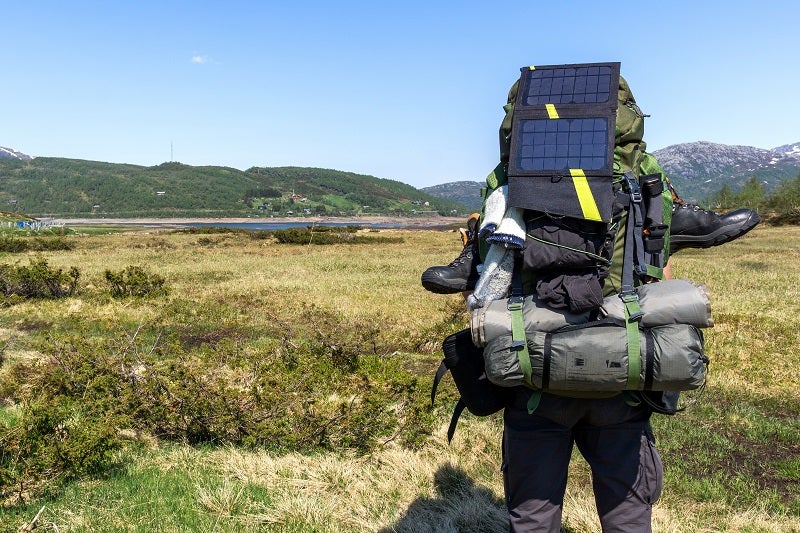
Solar chargers come in a wide range of sizes, prices and types. Small differences like the material and the efficiency of the solar panels can have great impact and result in benefits or disadvantages.
Your usage, terrain and charging needs will also influence your decision. In the following, we’ll explain key factors to help you pick the best portable solar charger for you.
Keep in mind these solar chargers are for small electronics only, if you require more power see our reviews on portable power stations.
Considerations For Solar Powered Phone Chargers
When picking a solar charger for your outdoor activities, let yourself be guided by the following questions:
Which devices will you bring?
For a small phone or GPS, a panel with low specifications can suffice. If you’re charging power-hungry electronics two at a time, you need something with a little more steam.
Pay attention to the connectors: most chargers will offer you a USB port, which work well for most modern electronics, but your particular device might need an adapter.
Where and how will you charge?
Solar chargers can be attached to a backpack, bicycle or motorbike to collect sunshine while you move, but they shouldn’t weigh or slow you down.
Compare weight and pack size and consider the surface area over which you can spread solar panels during your particular application.
If you’re charging in your camp, you might have a large area available, but on the go, compact could be better. And if you’re really roughing it in harsh conditions while wild water rafting or ice climbing, a more rugged model might be for you.
Do you need an internal battery?
Some solar chargers come with an integrated battery, giving you the option to charge your device from that.
This setup can give you greater ease-of-use or be ideal for situation where you need your device during sunshine hours and prefer to tether it with charging cables. You can power up a battery during the day and charge your electronics at night.
Integrated Battery
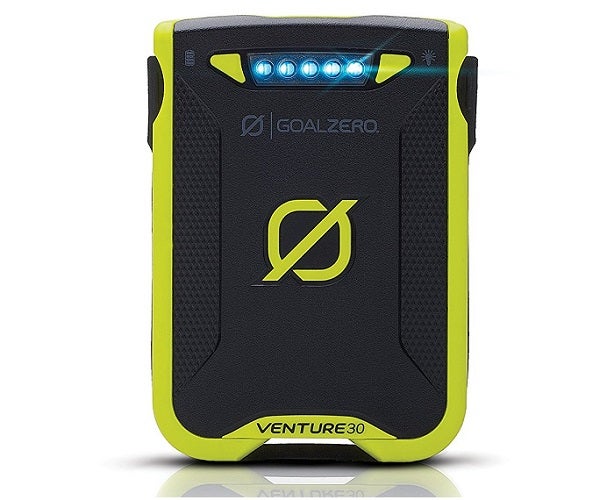
As you will have noted from our reviews above, some solar chargers come with an integrated battery, giving you more charging options.
Any solar power pack without a battery can of course be paired with an additional power bank. The downside of bringing a battery is weight and bulk, but it frees up your device during sunshine hours when you have the option of charging the battery instead.
Keep in mind that with batteries becoming more powerful and more efficient, your solar charger might be overkill. If you’re going on a two-day hike or a weekend camping trip, a battery pack of 10,000mAh and beyond is enough to top off your smartphone twice.
Beyond three days with a power source, a solar charger is definitely starting to look attractive.
Solar Panels
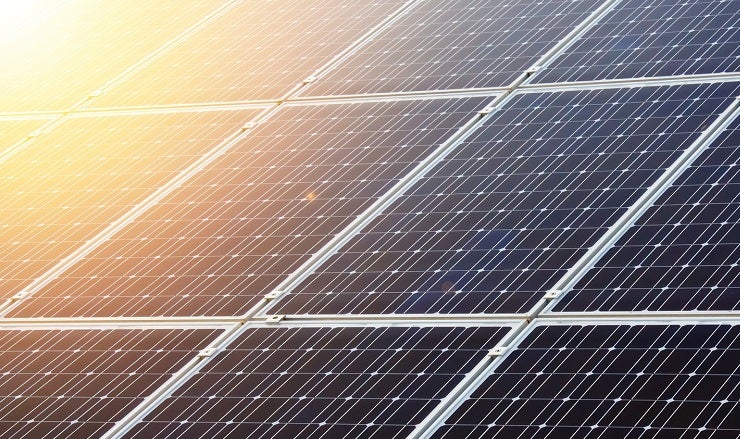
There are three different types of solar panels used in solar chargers. CIGS panels are the most flexible ones, as they’re made of a thin film of copper, indium, gallium and selenide.
They’re lightweight and cheap to manufacture, but they degrade quicker and have a lower efficiency. None of the chargers above therefore use CIGS panels, so that it comes down to Polycrystalline and Monocrystalline panels.
As the name suggests, the former uses multiple crystal ingots, whereas the latter is made of a single crystal ingot. In other words, Monocrystalline panels are “purer” with less energy loss and higher efficiency, whereas Polycrystalline panels are slightly cheaper to manufacture.
Monocrystalline panels are notably rugged and durable, which make them perfect for taking with you into the great outdoors. They’re very rigid, however, so you’ll need to plan on how you’ll be traveling with them. These panels appear black and are comprised of a single crystal ingot.
Polycrystalline panels appear blue and are made up of multiple crystal ingots and are slightly less expensive to make.
While the latter is more affordable, for small-scale consumers we highly recommend monocrystalline due to improved performance.
Panel Efficiency
This percentage specifies how effectively the solar panels can convert sunlight into electricity. A higher efficiency value is therefore better.
Currently, Monocrystalline panels can reach values just beyond 20% and up to 24% or 25%, whereas Polycrystalline panels stay just below 20%, typically around 18%.
Technical Specifications
Just what exactly do the technical terms associated with solar chargers mean? Wattage and amperage are the two values to which you need to pay attention when looking at the performance potential of solar chargers.
Electric current (the “flow rate”) is measured in amperes, whereas electrical power is measured in Watts. Panels with 3W to 5W are sufficient to charge smaller devices and older smartphones as well as batteries.
Even a full day of sunshine might not give you enough power to charge a hungry device such as a tablet or flagship smartphone.
With a 5W panel, a full charge could be 3 to 6 hours. Charging two devices at once is only possible with 10W and beyond. Amperage will tell you how efficiently a device can be charged.
Values here will top out at 2A or 2.5A. Pay attention to dual port chargers, as manufacturers use different specifications.
Some will tell you the output of both ports combined, while others specify output for each port, leaving it up to you to add these values up.
A charger that can deliver 2A on one port and 1A on the other is more efficient than a charger that can only deliver 2.5A over both ports (and thus 1.25A on each).
USB Connectors
As you can see, USB ports are the de facto standard for solar chargers, making it straightforward to charge smartphones and similar devices. Of our picks, only the Goal Zero was able to charge a 12V device out of the box.
Keep in mind which of your devices need adapters – again, your best bet might be to power them from a battery pack charged by your solar panels as you will lose power in the conversion.
Ease of Use
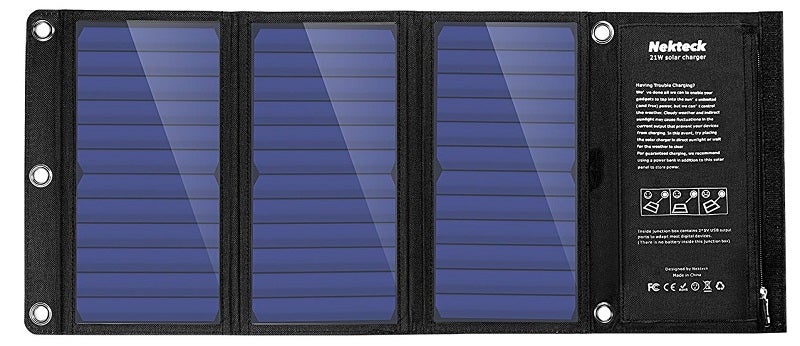
Solar chargers seem to be an easy thing to set up: hook up your device, expose the charger to the sun, and harness free power.
Most panels are cleaned easily by wiping away dust or moisture with a cloth. But look out for smart charging technology, which any good solar charger should feature.
This microchip will not only adjust the charging automatically to the connected device for safety and efficiency, it will also re-start the charging after an interruption.
This could be a passing cloud, shade from a tree or a person blocking the sun. Devices without this technology can get stuck in a slow charging mode, requiring a manual reset by unplugging the replugging your setup.
Also think of how you will be charging mostly: with a stationary setup outside your tent, or with the charger on your backpack, bike or motorcycle? A panel’s correct angle helps to greatly increase efficiency.
The rule of thumb is that your panel needs to be facing towards the sun at an angle roughly equivalent to your latitude.
Generally, this will result in shallower angles in the summer and steeper ones in winter. If you can make adjustments throughout the day, you can speed up the charging. Consult Solarpaneltilt for more specifics.
A panel strapped to a backpack is easy to carry but usually results in two thirds of a foldable charger to be hanging down more or less vertically, which only works if you’re hiking with the sun at your back.
If strapping the charger to your pack is your setup, learn the best angle for your terrain through experimenting. Many chargers also include a pocket for cables and devices, but pay attention to how hot they can become inside. You don’t want to be roasting your device while you charge it.
Size & Weight
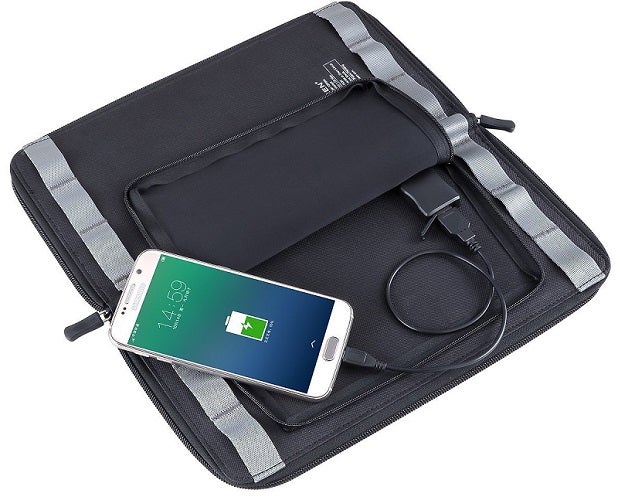
Of course, the ideal solar charger would be light and small, but due to the nature of solar panels, this is hardly an option.
The more power you need, the bigger the surface area of the panel has to be, making foldable chargers with efficient panels a sure bet for charging more than one piece of electronics.
An integrated battery adds significantly to the weight, whereas a battery pack with a small panel is relatively compact at the cost of slower and less powerful charging.
Know your pain points for bringing extra bulk on your outdoor activities. The combination of a foldable panel with a separate, external battery pack gives you liberty in stowing them apart and picking the power bank of your size, weight and need.
Wattage
Ultimately, those panels with a larger capacity are the most effective. While they may be notably bulkier, they’re ultimately going to get the job done faster and more efficiently which is crucial if you’re out in the middle of nowhere or if you have an emergency. I
We also want to advise you against opting for cheap, smaller wattage models just to save a few bucks. They’re often not going to be worth it and you’re going to be sitting there for an hour watching the battery percentage move up by 1.
Extras
While on their own they may not make or break a product for you, together they may sway you into purchasing a particular model. Extra accessories can easily add up so when they’re included for free, it’s always a nice bonus.
Most solar panels come only with a USB connector, as the majority of our modern-day devices only require these connections. However, there are some which come with many more goodies, like adapters, alligator clips, charging indicators, carabiners, and more!
Just remember that there’s no need to focus on extras that you don’t even need, so first make sure they’re something you actually want.
FAQs About Solar Chargers
Q: What are solar chargers?
A: These little devices produce energy from the sunlight it absorbs. They’re much more portable than most other solar power units, meaning you can take them just about anywhere you need power. They’re most often used to charge smart devices like tablets or smartphones.
Q: When are solar chargers best suited?
A: That depends on the model you’re going for. Smaller chargers are ideal for emergency situations, as they’re not often strong enough to keep electronic devices charged all weekend. Larger/more powerful chargers work well during camping trips or any other time when you’re in a remote area and don’t have access to a wall plugin.
Q: About how long do the smaller chargers take to fully charge up?
A: The average model will take about 2 hours to charge half of the battery. We’re not saying it will take 4 hours to charge the entire battery, as this is oftentimes not the case. Many batteries actually slow their roll and take longer to charge once they get past the 50% point. With that being said, they may take around 6 hours to fill up.
Q: Do solar phone chargers really work?
A: portable solar phone chargers will charge not only your phone but other small electronic devices like handheld GPS units, lanterns and flashlights. They will not charge as fast as a wall outlet but they are effective.
Q: Are solar chargers worth it?
A: If you are looking for power to charge your portable electronic devices where electricity is not available, then yes a solar charger is definitely worth it. They have come down dramatically in price and can be had for under $50.
Q: Do solar chargers need direct sunlight?
A: While a solar panel can work from indirect light such as under a tree the power the solar panels produce is substantially less than putting the panel in direct sunlight.
Q: Do solar chargers work on cloudy days?
A: A solar charger uses photons from the sun to convert them in electrical power. As long as they are able to receive them from the sun they will produce some power. However it will be dramatically less than a sunny day. You may only get 15% to 25% of the power from direct sunlight.
Tips For Using Your Solar Charger
#1: Make sure that your solar charger is fully charged before you even leave the house.
Just make sure that you don’t charge it too long before your trip, because if you wait too long to use the charge you can actually lose it!
#2: Try to avoid completely using up a device’s battery before recharging it.
#3: If you’re going to be in extreme temperatures, make sure your device can operate safely in them.
Most of the chargers worth using will be able to handle anywhere from around 14 to 195 degrees Fahrenheit, but it’s crucial that you double-check before heading out.
#4: Remember that you won’t always have ideal conditions to keep your solar charger powered.
Even if you’re going to be out in the middle of a blazing hot desert, try to take advantage of ideal conditions when they come along, to try and avoid running out of power.
Final Thoughts
The variety of different solar chargers can make it an intimidating task to pick the right one, so start with the absolutely essential devices you need to bring on most of your outdoor trips.
What will your typical charging situation and setup look like, and are you just using a single GPS, or do you need to charge a phone, battery pack and more? Then match your needs to our picks above with the help of our guide.
Solar chargers with less Watts are cheaper, yet less powerful. A more expensive model will not necessarily make you happier, depending on your need. The more you’ll be charging, the higher the output and efficiency needs to be.
How We Researched
To come up with the top solar chargers we researched a variety of sources for reviews such as REI, Bass Pro Shops, Cabelas and Backcountry along with our own personal experience.
We also consulted online magazines for product research and reviews to get as much unbiased information as we could. To help weed out fake reviews we used Fakespot.com to make sure we only looked at genuine reviews.
With so much quality gear available, we had to narrow it down based on what we felt were the best options for the price. The author, Casey Fiedler has been leading backpacking trips for over a decade in his native state of Michigan.
To help narrow down the selection he used his personal experience along with recommendations from fellow guides and outfitters.
After extensive research, we came up with our list to help you choose the right one for you.
Sources
I hope this guide was helpful in picking a good backpacking solar charger to fit your needs. If you want to comment or recommend a model I didn’t include, please use my contact form to get in touch.
your outdoor adventures and remember to only bring the devices you really need!

